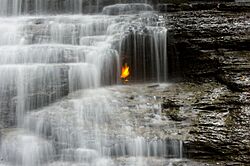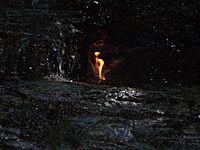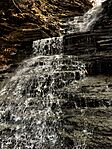Eternal Flame Falls facts for kids
Quick facts for kids Eternal Flame Falls |
|
|---|---|

The natural gas-fueled "eternal flame" below the falls in early spring, 2009.
|
|
| Lua error in Module:Infobox_mapframe at line 185: attempt to index field 'wikibase' (a nil value). | |
| Location | Chestnut Ridge Park Erie County, New York |
| Coordinates | 42°42′06.5″N 78°45′06.1″W / 42.701806°N 78.751694°W |
| Type | Cascade |
| Total height | 30 feet (9.1 m) |
| Watercourse | Shale Creek, tributary to Eighteen Mile Creek |
The Eternal Flame Falls is a unique waterfall in Chestnut Ridge Park, Western New York. It has a small cave, called a grotto, that lets out natural gas. This gas can be lit to create a small flame. The flame is usually visible all year. Sometimes it goes out and needs to be lit again.
For a long time, not many people knew about this special place. Now, more visitors come to see this amazing natural wonder. This is because more people have heard about it. Also, the path to the falls has been made better.
Contents
Understanding the Flame
In 2013, a group of geologists (scientists who study rocks and the Earth) decided to study Eternal Flame Falls. They came from Indiana University in the United States and Italy. They wanted to learn how natural gas leaking from the ground affects the air.
This gas contributes to greenhouse gases in the atmosphere. Greenhouse gases are important because they trap heat. They play a role in the Earth's climate.
Gas Composition
The geologists studied the gas coming from the main spot at the bottom of the falls. They called this a 'macro seep' because it's a larger leak. They found something interesting about the gas here.
Natural gas is mostly made of a gas called methane. But the gas at Eternal Flame Falls had more of other gases. These were called ethane and propane. About 35% of the gas they tested was ethane and propane. This is more than what is usually found in other natural gas leaks around the world.
They also guessed how much methane was coming out of the main leak. They thought about one kilogram (which is about 2.2 pounds) of methane was released each day. The researchers also saw many tiny spots nearby where gas was slowly leaking out. They called these 'micro seeps'.
Where the Gas Comes From
The geologists wanted to know where the gas came from deep underground. They compared the gas from the falls with gas found in wells drilled nearby. This helped them find the gas's source.
They found that the gas seems to come from a rock layer called Rhinestreet Shale. This layer of shale is about 400 meters (about 1,300 feet) below the surface! That's deeper than many tall buildings.
How Gas Travels Up
How does the gas get from so deep underground to the surface? Scientists think that movements in the Earth's crust cause cracks in the shale layer. These movements are called tectonic activity.
These cracks, or faults, act like tiny pipes. They allow the natural gas trapped in the shale to travel upwards. Eventually, the gas seeps out at the surface, creating the flame.
A Geologic Puzzle
The research at Eternal Flame Falls also brought up some interesting questions. Usually, natural gas forms in shale rock when it's buried very deep. It also needs to be very hot, around 100 degrees Celsius (212 degrees Fahrenheit) or hotter. This heat helps break down materials in the shale to make gas molecules like methane.
However, the Rhinestreet Shale at Eternal Flame Falls is different. It's much cooler than the temperature usually needed to make natural gas. It's also younger and not as deep as typical shale layers that produce gas.
This difference is a bit of a mystery! It might mean that there are other ways natural gas can be created. Scientists might not fully understand these ways yet. One idea is that something else in the cooler shale, like a special substance called a catalyst, helps make the gas. A catalyst helps a chemical reaction happen faster or at lower temperatures.
Protecting the Falls
As more people discovered the falls, it became more popular. It's great that more people can see this unique spot. However, more visitors also brought some challenges.
Unfortunately, very popular places can face issues. These include litter being left behind, damage to the area, and the ground being worn down by many footsteps.
To help manage visitors and protect the area, work was done on the main trail. In August 2023, the main trail in Orchard Park, New York, was re-opened after big improvements. This work included building 139 box steps. These steps help people get past a tricky and steep part of the trail. About 120 feet (35 meters) of railing were also added along the trail down to the creek bed.
Even with these improvements, getting down to the stream can still be a bit challenging. It's important for visitors to be very careful. They should wear the right kind of shoes, like sturdy hiking boots, to stay safe.
Gallery
See also









